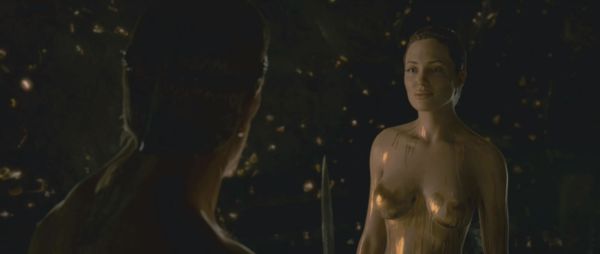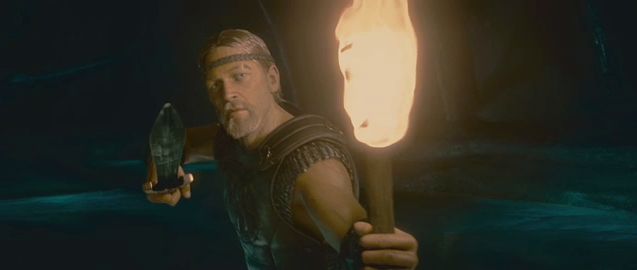Beowulf (Robert Zemeckis, 2007)
Beowulf is a test-bed for a combination of technologies that might be the future of the movies. It utilises “performance capture” animation, which some think will revolutionise computer animation. In many theatres it is being exhibited in 3-D, and that technology is acting as something of a trojan horse for the accelerated roll-out of digital cinemas. And its regular theatrical release is paired with showings in IMAX. It’s all very reminiscent of the 1950s, when extreme widescreen processes and early 3-D were used to try to give theatrical exhibition a competitive advantage against the threat of television. Today, the threats are DVD and illegal downloads, but the impetus is much the same. And Robert Zemeckis, in particular, has devoted much of the last decade to this technology: he hasn’t made a live-action film since 2000’s Cast Away, and won’t for some years (with his next picture locked in as the computer-animated A Christmas Tale, due in 2009).
Beowulf is the most interesting test-case yet as to whether this technology is worth the investment that Zemeckis and other high-profile directors have made in it. Zemeckis’ last film, The Polar Express, was more oriented towards traditional audiences for animated features, and its distinct visual look at least had some basis in the highly photo-realistic visual style of the original picture book by Chris Van Allsburg. Zemeckis’ Beowulf certainly isn’t kiddie fare, however, and it sees the animation technology employed for material much closer to the heart of mainstream filmmaking. While Zemeckis is adapting an Old English heroic poem, the resulting film is a modern adventure / fantasy epic in the Lord of the Rings template. An ancient Scandinavian kingdom is terrorised by the monstrous creature Grendel, and the call goes out for a hero to slay the menace. From across the sea comes the adventurer Beowulf. While some in the court doubt his credentials, Beowulf proves himself in battle. Before the film is over, however, he has to face still more imposing menaces.
It’s fun seeing the movie in 3-D, and I recommend doing so, but I’m not convinced this is the future of cinematic story-telling. The polarised lenses used on the glasses are a huge advance on the old red-and-blue cellophane versions, but this is still imperfect technology: the feeling of depth is striking, but the image isn’t quite as sharp as a conventional image, and tilting your head too much causes the whole effect to stop working. (And that’s on top of any extra problems you might have if your vision is less than perfect.) Of course, there are benefits from the process, but they aren’t revolutionary. I don’t know, for example, that there is a greater sense of immersion in the story just because the film’s depth is more “realistic” – if anything, the startling depth distracted me out of my involvement in the film’s world. Creatively, the 3-D effect really only offers up the chance to occasionally startle the audience with objects flying at them (or the occasional sweeping flight through 3-D forests). It’s the same cheap trick that directors in the format have offered up since the original 3-D boom in the1950s, and while it’s nifty enough, Zemeckis doesn’t discover any previously untapped artistic possibilities from the process.
Similar comment could be made about the animation, achieved through performance-capture technology that maps the movements of real actors onto computer models (I discuss the implications of the film for the art of animation in more depth here). The characters veer so close to photo-realism that the uncanny valley effect frequently makes them creepy to look at, and the resemblance of many (most notably Anthony Hopkins’ Hrothgar) to the actors who play them makes the use of animation seem pointless. The women are particularly poorly realised, with Robin Wright Penn’s Wealthow a stiff mannequin, and the Angelina Jolie-derived Grendel’s Mother not much more than a showcase for state-of-the-art computerised breast simulation. The process does allow some stunt casting, with Ray Winstone turned into a buff Sean Bean lookalike. But even then the process seems like an elaborate technological fix for a miscast role: Winstone’s London accent is an odd choice for Beowulf. Only in the character of Grendel does there seem some legitimacy in the process. Crispin Glover – apparently having patched up the dispute with Zemeckis that kept him out of the Back to the Future sequels – does a Gollumesque turn as the tormented creature, and Grendel is the one character that really shows the performance capture sensibly used.

Once we look beyond the technology, and see Beowulf as a conventional fantasy movie, it can be seen as a decent but unexceptional fantasy epic. The screenwriters, geek favourites Roger Avary (best known for his collaboration with Quentin Tarantino on Pulp Fiction) and Neil Gaiman (a respected author of comics as well as fantasy and science fiction novels), have turned the Old English poem into a serviceable basis for an adventure epic, structured around a series of often-gruesome battles. Beowulf himself is an interesting but puzzling hero. At first he is presented as a teller of tall-tales, and we are invited to doubt his credentials as a slayer of monsters. We quickly discover that he is capable of the heroic deeds he claims – but the questions surrounding his honesty and character form the basis for the second half of the film.
There’s nothing wrong with the script, and Zemeckis – amongst the flashiest and most audience-focussed directors there is – always keeps it visually interesting. So it’s entertaining throughout. Yet it also feels pieced together from things we’ve seen before. While I haven’t truly loved anything Zemeckis has done since the 1980s, there was a sense with something like Forrest Gump that – for all its flaws – its bold technical leaps were charting some new territory. Beowulf gives the distinct impression that Zemeckis, while fiddling around with the computers, has fallen off the crest of the wave creatively. Every scene in Beowulf is spectacular, but in a manner that recalls another spectacular scene in a recent movie: the big opening battle between villagers and Grendel recalls the battle with the troll from Fellowship of the Ring; the locales recall parts of The Two Towers; and the final battle with the dragon recalls a similar battle in Harry Potter and the Goblet of Fire. So as fun as Beowulf often is, it ultimately feels as if you are being shown a new, fandangled way to present things you’ve already seen before.
Related Items
My more detailed discussion of the implications of Beowulf for animation is here.
